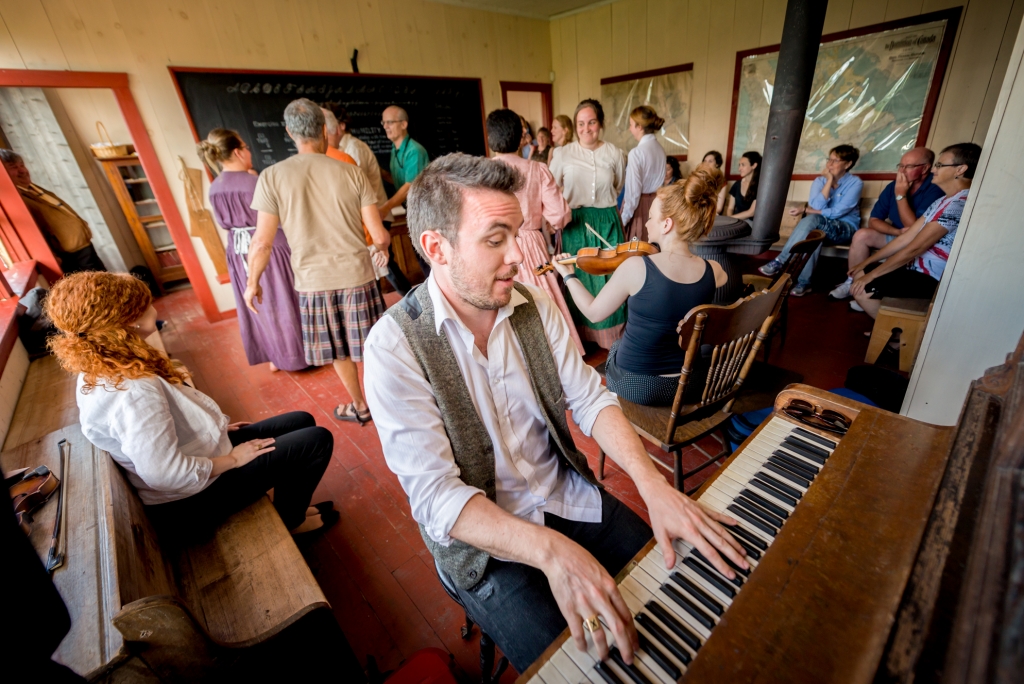
Music in the Maritimes
June 17, 2021
Music is part of the DNA of all the Maritime provinces. Discover a rich and diverse artistic history that will get your toes tapping and your head bobbing!
The Maritimes have always been a hotbed for music and an integral part of each province’s cultural fabric, from Prince Edward Island to Nova Scotia to New Brunswick. You’ll hear music in homes as people gravitate to the kitchen, where the music, food, conversation, and beverages flow. From cities to small towns, annual music festivals bring music lovers of all ages and all tastes together — often outdoors under a beautiful Maritime summer sky. Traditional music always holds a special place in Maritimers’ hearts around the world, but the thriving arts and culture of the East Coast touches on everything from R&B to country, and beyond.
When you’re ready for your next Maritime adventure, keep your ears open for the music that goes hand-in-hand with the rugged coastlines of Nova Scotia, the gentle beaches of Prince Edward Island, and the dynamic tides of New Brunswick.
Here’s a look at the proud history of music in the Maritimes, highlighting some of the best artists and performers from the past as well as the exciting musicians making art here today.
Traditional Roots

When you hear the words “traditional music” and “Maritimes”, instruments such as the bagpipes and fiddle often come to mind. Nova Scotia has a rich Celtic culture from when Gaelic-speaking immigrants arrived in the area from Scotland and Ireland. Along with these instruments, the Gaelic settlers brought the tradition of céilidh — a gathering, like a kitchen party — which brings together people with music, step dancing, and storytelling for a fun social time. This language and culture are preserved in Cape Breton at Colaisde na Gàidhlig or the Gaelic College in St. Ann’s on the Cabot Trail. If you take a road trip from Caribou, Nova Scotia, where the ferry docks, up to Cape Breton, you may notice many of the road signs are in both English and Gaelic. Celtic music has strong roots in Prince Edward Island as well. In fact, Summerside is the home of the College of Piping and Celtic Performing Arts of Canada.
The Acadians have lived in the Maritimes for over 400 years after arriving from France. Music and song have been an essential part of this culture for centuries. Today, many of the traditional songs have been passed down from generation to generation, preserving the French-language songs. Traditional Acadian music evolved in different directions throughout the Maritimes. In some Acadian towns, like Chéticamp in Cape Breton, there are more Scottish influences, which can be heard in their fiddling. Meanwhile, in southwestern Nova Scotia along the Bay of Fundy, there’s more influence from rock, bluegrass, and country.
For thousands of years prior to settlers arriving in the Maritimes, Indigenous cultures lived in the region. Mi’kmaq traditional music is another way of preserving culture through song and dance, often with traditional instruments such as the Ji’kmaqn, a chanting stick that’s about a foot long with split ash wood at one end and unsplit wood at the other end for a handle.
Roots Revival

While traditional music is woven into the Maritime fabric, it has seen wider popularity surges in both the 1970s and late 1980s. Songwriter Stan Rogers was born in 1949 in Ontario, but his family was from the Maritimes. He would spend his summers visiting family in Guysborough County, Nova Scotia. Eventually, his Aunt June convinced the young musician to write songs about his roots. He became one of Canada’s most popular songwriters, bringing the stories of the Maritimes to the rest of the world with his folk music. His legacy lives on at the annual Stan Rogers Folk Festival in Canso, Nova Scotia.
In the 1960s, New Brunswick’s Don Messer popularized an old-time fiddling style called Down East. He started playing music in his home province before moving to PEI, where he formed Don Messer and His Islanders in Charlottetown. His Down East style continues to be popular in traditional fiddle music, especially Acadian music in certain regions.
In the 1980s, Celtic music also had a huge revival, with the platinum-selling artists The Rankin Family from Mabou, Nova Scotia. This continued with fiddlers like Ashley MacIsaac and Natalie MacMaster winning awards and collaborating with major international artists. Prince Edward Island’s Lennie Gallant also gained popularity around this same time with his folk-rock and country music inspired by his home province. Shortly after this, Barachois, an Acadian traditional music group from PEI, brought their fiddling and step dancing to stages across North America.
The Next Wave of Maritime Music

Traditional music has dominated the Maritimes for a long time, but the arts and culture scenes continue to evolve as diverse genres shape the sounds coming out of these provinces. Local bands touch on every genre, from rap to electronica to heavy metal. Up-and-coming country musician Makayla Lynn, originally from Elmsdale, Nova Scotia, is currently making waves in the Nashville country music scene. Jeremy Dutcher, a performer and composer from Tobique First Nation in New Brunswick, captivates audiences with performances and recordings that preserve his Wolastoqey language. His first album Wolastoqiyik Lintuwakonawa won the Polaris Music Prize in 2018, a prestigious award given to the best Canadian album based on merit. It also won a Juno Award as the Indigenous Music Album of the Year. The community of North Preston in Nova Scotia has a rich gospel music history and continues to produce unforgettable musicians like Keonté Beals. The R&B musician with an attention-grabbing voice was Music Nova Scotia’s African Nova Scotian Artist of the Year in 2019. Beals has also received multiple East Coast Music Award nominations to start a promising career. These are just a few examples of the future of Maritime musicians, whose art will be appreciated for years to come.
The next time you’re ready for an adventure through the Maritimes, put on your favourite East Coast tunes as a soundtrack while you explore these beautiful provinces. And if you’re looking for something to listen to while you relax and watch the ocean waves from the ferry, we’ve put together a 75-minute playlist of the best Maritimes music just for you. Why 75 minutes? Because that’s the same amount of time it takes to cross between Wood Islands, PEI and Caribou, Nova Scotia on the mv Confederation and mv Holiday Island.

Explore the Maritimes
Whether you’re searching for a journey on the high seas or adventure on dry land, we have a little something for everyone. Explore Today